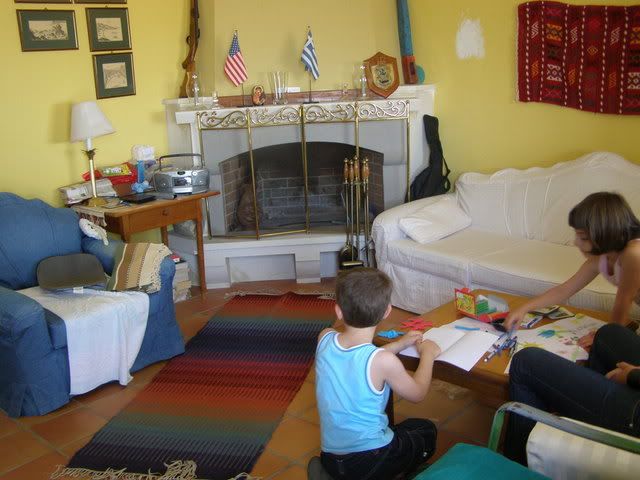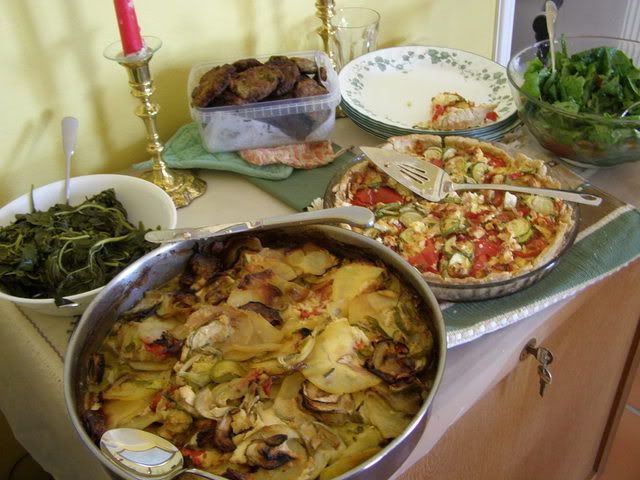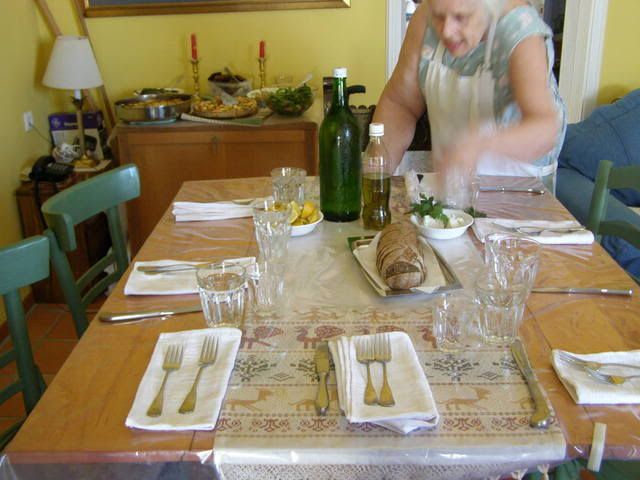INTRODUCTION:
People's dietary habits differ all over the world, with the result that when they leave their home territory, their dietary choices may not be available in their new place of residence. This invariably results in replacing food items that cannot be sourced in certain parts of the world with a foreign equivalent, or in extreme cases, doing without.
Kentucky Fried Chicken (KFC) is well known all over the world, but not in Hania, Crete. What happens when an American family from Louisville, Kentucky (don't pronounce the 's'), the headquarters of KFC, comes to live in Kolimbari, Chania (don't pronounce the 'C'), where KFC does not (yet) exist?
How will their dietary habits change? What substitutions and replacements will have to be enlisted in order that their daily dietary KFC doses will not suffer adversely? Is it possible for a Kentuckian to survive on the Mediterranean diet?
LITERATURE REVIEW:
The rates of obesity in the USA are constantly under discussion. The situation is being treated as an epidemic by many specialists: unhealthy diet coupled with lack of exercise and an addiction to sedentary activities, notably the internet, have led to a decline in the health of the average Americans.
In The Omnivore's Dilemma (2006), Michael Pollan points out that the average American's diet consists of corn-based food products, most of which are prepared in industrial kitchens (hence the term "industrial eater"), the kind usually served in fast-food outlets and store-bought ready meals, and eaten mainly by sitting on a couch watching television or in a fast moving car. Houses are even designed with a non-functional kitchen and just a microwave oven to heat up ready food (as Joanna Blythman claims in Shopped). Corn is fed to animals used in the consumer food market, such as chicken and beef, staple parts of the American diet. It is also used in other food products in the form of flour, preservatives and other food-related ingredients, even in the pesticides that are used to ensure a healthy bushel of corn. The problems inherent in such an agricultural system are mainly those related to non-sustainability and the cruel nature of growing food for fuel instead of starving people.
This is in stark contrast to the diet practiced by many residents of Crete, in accordance with the food pyramid of the Mediterranean diet (Verivaki, 2007-2008). Although supermarkets in Crete do sell prepared food in cans and plastic containers, it is not available in great quantities, nor is it treated as a staple food source. Fast food outlets do abound on the island, so it is expected that a Kentuckian will be using their facilities as a meal replacement service, given the absence of KFC.
While Americans source their food in supermarkets and the likes of McDonalds and KFC, the Cretans subsist mainly on local food which they have grown and harvested themselves. Although television features in various degrees of priority in both locations, there would be very few homes in Crete which do not own a table large enough for one's family to dine on, despite the fact that this worrying trend has been seen to intrude i various households on the island.
The purpose of this thesis, oops, sorry, I meant post, is to provide a descriptive account of the food lifestyle of the Hanioto-Kentuckians.
MATERIALS AND METHODS:
The data used in the thesis (of course, I meant the post) were gathered through the use of:
- casual interviews with the subjects (n = 2, no males)
- a meal prepared by the subjects in their Cretan home
- the contents of the subjects' fridge
- foods from the Mediterranean diet range presented to the subjects
1. What do you do for a living? (Sedentary jobs, no doubt...)
S1 is an occupational therapist, while S2 needed new kneecaps and hips, no doubt partly due to the archaeological digs she has been participating in for the last 25 years. There isn't a moment to sit around...
2. When you are in Crete, what physical exercise do you take? (I'll bet it's the gym...)
S2 has been swimming all her life, even though she doesn't live near the sea. She first crossed a river close to her home in Pennsylvania when she was only four years of age. S1 swam before she could walk because her mother (S2) was worried she might fall into someone's swimming pool and drown herself, so she taught her how to swim form a young age. They are both able to tackle Kolimbari Beach, which is very stony and deep, playing host to a dangerous riptide every now and then. S2 has also been known to hose down neighbours who spray her freshly washed laundry with water mixed with concrete from their newly constructed house. Although the subjects are both very active, they did not partake in the tomato pelting fight which took place between two neighbours; they were very thankful guns were not used instead.
3. How far away is your local 'fastfoodadiko'? (This place sure looks like the wop wops...)
Neither S1 nor S2 have any idea where the local souvlatzidiko is. They must miss KFC a lot.
4. Where do you eat your meals? (Oh, shit, there's a table in here...)
All meals are taken on a Shaker-design table which S2 made herself. In fact, all the furniture in their home is hand-made Shaker-style by S2, including a rug, made on a traditional Cretan weaving frame, called an argalio, and the covers of the living room suite.

5. Where do you source your food when living on the island? (I mustn't lose my focus...)
"We grow our own weeds," they proudly told me. The garden contains lettuce, peppers and glistrida (purslane). Basil decorates the balcony as a pot plant (and I can smell it cooking in the kitchen).

6. What do you keep in your fridge? (I'm curious...)
Apart from a carton of juice and some containers full of cooling water, half the fridge had been invaded by a 15-kilogram watermelon. There were also an incredible number of corked wine bottles in the fridge, all of which have been presented as gifts (but never imbibed) from friends passing by to see them in their Cretan home in Grimbigliana, a hamlet of the coastal village of Kolimbari, west of Hania. The house itself was part of a former Turkish court, of which the fortifications and the stonework of the court, dating back to the 1700s, can still be seen today, against a background of terraced fields where wheat was once grown.
7. How often do you eat meat? (Not a cow or chicken in sight...)
Despite expecting otherwise, no corn-fed cows were to be found in the vicinity of the house. S1 is a vegetarian; she only eats chicken when she goes out for dinner in Crete and their Cretan friends deliberately over-order, as they regard her as under-fed. S2 is tired of cooking after mothering four daughters and would love to eat something cooked by anyone else other than herself. Her youngest daughter, also a vegetarian, has just had the healthiest grandchild S2 has seen so far, over 9lbs. (The answer to this question has obviated the need to ask how long it's been since the subjects had KFC).
8. Can you name these foods? (Worth a try...)
"Oh my God, you bought us some horta! Oh, you didn't bring a boureki, did you? You made courgette patties especially for us?"

9. What are we eating today? (I'm hungry...)
S2 made a tomato and courgette quiche, using a Southern recipe for the crust. It had a sprinkling of basil on it, an unusual herb for Crete. Anne whipped up a green salad with red peppers. There was also anthotiro, a soft white local variety of Cretan cheese, and multi-grain bread from Drandakis bakery in Akrotiri.

10. Why do we need two forks, Mum? (Thanks for the question, Aristotle)
I don't know, son.
11. Hey, what's that gun doing over the fireplace? Do they go hunting? (???)
Oh, go ask Alice, please, Dimitri.
12. How on earth does S1 keep so slim? (If I ask this one, I'll only be drawing attention to myself...)
DISCUSSION:
Tomato quiche with Mama's crust is finger-lickin' good.
I must remember to take back my baking tin.
The framed flag on the wall travelled from England (as a scarf on an RAF soldier's neck) to Greece, to the USA, and back to Greece again; the rudder to the right of the fireplace is from a boat owned by a friend who also owned the gun (it doesn't work).
Is there a Shaker furniture store in Hania?
Who's your daddy?
CONCLUSION:
The Mediterranean cuisine has had no effect in the dietary habits of the Kentuckians surveyed, although this must be verified with a greater sample size. Future research could focus on the availability of Cretan food in Kentucky, as this is what is actually eaten by the subjects where they live most of the time...
ACKNOWLEDGEMENTS: I am indebted to Anne Clarke and Allis for inviting me to lunch at their home in Grimbigliana, Kolimbari, Hania, Crete.
©All Rights Reserved/Organically cooked. No part of this blog may be reproduced and/or copied by any means without prior consent from Maria Verivaki.
This is a wonderful post Maria.
ReplyDeleteMaria,
ReplyDeleteYou are teaching people to stay away from obesity!
This is a pretty difficult job to do,haha..I think this has a lot to do with genes...
Wow! You put a lot of work into this one. Humorous, too. Unless I went to China or someplace where they eat many, many things I would refuse to put inside of me, I would be fine most anywhere I could find some fresh produce.
ReplyDeleteKFC? It was the first fast food restaurant to go into Iceland. I lived there for a little while, and I don't think I ate it one time!